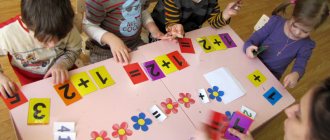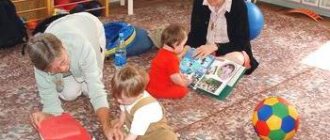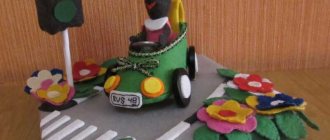Methods for forming the concept of number
Research in the field of the formation of elementary mathematical concepts in children is directly related to practice and provides scientific ways to solve its most important problems. The developed content, methodological techniques, didactic means and forms of organizing work are used in the practice of forming elementary mathematical concepts in children in kindergarten. The publication of the main results of the study makes them available to a wide circle of preschool workers. The recommendations of scientists are taken into account when revising the program for the development of elementary mathematical concepts in kindergarten.
.Methods of forming the concept of number and shape in children were reflected and further developed in the systems of sensory education of the German teacher F. Froebel (1782-1852) and the Italian teacher M. Montessori (1870-1952).
In classical systems of sensory education, the issues of familiarizing children with geometric shapes, quantities, teaching counting, measurements, arranging rows of objects by size, weight, etc. were specifically considered. F. Froebel saw the tasks of teaching counting in the assimilation of a series of numbers by preschool children. He created the famous “Gifts” - a manual for the development of construction skills in unity with the knowledge of numbers, shapes, sizes, and spatial relationships. M. Montessori, relying on the ideas of self-education and self-education, considered it necessary to create a special environment for the development of ideas about number, shape, quantities, as well as the study of written and oral numbering. She suggested using counting boxes, bundles of colored beads strung in tens, abacus, and coins for this purpose.
Progressive teachers of the past, Russian and foreign, recognized the role and necessity of primary mathematical knowledge in the development and education of children before school, highlighted counting as a means of mental development and strongly recommended teaching it to children as early as possible, from about three years of age. They understood learning as exercise in practical, playful actions using visual material, reproduction of the experience accumulated by children in distinguishing numbers, time, space, and measures.
The possibilities of forming quantitative concepts in young children and ways to improve quantitative concepts in preschool children were studied by V. V. Danilova, L. I. Ermolaeva, E. A. Tarkhanova.
The content and methods of forming spatio-temporal representations are determined on the basis of a number of studies by T. A. Museyibova, K. V. Nazarenko, T. D. Richterman.
Methods and techniques for pedagogical guidance in the mathematical development of children through games were developed by Z. A. Gracheva, T. N. Ignatova, A. A. Smolentseva, I. I. Shcherbinina.
Currently, the possibilities of using visual modeling in the process of learning to solve arithmetic problems (N.I. Nepomnyashchaya), children’s knowledge of quantitative and functional dependencies (L.N. Bondarenko, R.L. Nepomnyashchaya, A.I. Kirillova), and the abilities of preschoolers are being explored to visual modeling when becoming familiar with spatial relationships (R. I. Govorova, O. M. Dyachenko, T. V. Lavrentieva, L. M. Khalizeva).
The results of scientific searches by psychologists, mathematicians and teachers created the need to improve the program for the development of elementary mathematical concepts in preschoolers (sections “Magnitude”, “Geometric figures”, “Orientation in space and time” were introduced).
The authors of these works propose to form mathematical concepts taking into account the various impressions children receive in everyday life. They consider learning in a unique way: while proving the need for games and exercises with children, the authors do not recommend strictly observing the requirements for the quality of mastering educational material. During the training, significant attention is paid to developing in children the ability to apply acquired knowledge in practice. This is achieved through the use of environmental objects and practical and playful motivation for special exercises as visual material.
Introducing mathematics in a playful way
For a child, everything in the world is a game. And the game is both study and work, and a way of understanding reality. It needs to be included in the educational process. That is, to lead, direct, organize. Thus, it is possible to influence different aspects of the personality: in total, sensations, consciousness, will and behavior.
Children enjoy play activities as a process. Teachers and parents have a different goal. They need to develop a preschooler, put certain knowledge into his head, and develop personal qualities. Didactic games and exercises are especially useful. They provoke relaxed interaction between participants and teach them how to communicate.
Board games are very helpful in forming ideas about forms, sequences, contradictions and other things. They save you right away. You can make cards for such games yourself. But there are ready-made game sets, they are bright and cost a penny. This is for example:
- lotto “Logical tables” for 3-6 years;
- games like “What’s extra?” (there are many options, for example this one from 3 years old and this one for 4-7 years old );
- funny toy “Whose cat is bigger?” to compare numbers;
- "Find a similar figure";
- "Katamino" (mini road version) develops spatial thinking.
Developmental environment
The developmental environment is a system of material objects of a child’s activity that functionally model the content of his mental and physical development.
The physical and developmental environment is organized in such a way that every child has the opportunity to freely do what they love. The arrangement of equipment by sectors (development centers) allows children to be grouped into subgroups in accordance with their common interests: design, drawing, handicrafts, theater and play activities, experimentation. Materials that activate cognitive activity are required in the equipment: educational games, toys.
The kindergarten environment should ensure the safety of children's lives, promote the health and strengthening of the body of each child.
When creating a subjective development environment, you need to remember this:
- The environment must perform educational, developmental, nurturing, stimulating, organizing and communicative functions. But most importantly, it should work to develop the child’s independence and amateurism.
- 2. flexible and variable use of space is necessary. The environment must meet the child's needs and interests.
- The shape and design of the items are based on the safety and age of children.
- decorative elements should be easily interchangeable.
Each group should have space for conducting experimental activities with the participation of children.
- When organizing the subject environment in a group room, it is necessary to take into account the patterns of mental development, indicators of their health, psychophysiological and communicative characteristics, the level of general and linguistic development, as well as indicators of the emotional sphere and the sphere of needs.
- the color palette should be represented by warm pastel colors.
- When creating a developmental space in a group room, the leading role of play activities should be taken into account.
- Depending on the age characteristics of the children, the period of study and the educational program, the object environment for the development of the group should be changed.
It is important that the physical environment is an open system, not a closed system, that can adapt and evolve. In other words, the environment not only evolves, but also develops. Under any circumstances, the objective world that surrounds the child must be replenished and updated in order to adapt it to the new way of life of a given age.
Thus, when creating an object-developmental environment for any age group in a preschool institution, it is necessary to take into account the psychological foundations of constructive interaction between participants in the educational process, the design and ergonomics of the modern environment of a preschool institution, as well as the psychological characteristics of the age group for which the environment is intended.
We are talking about the age of the child, he has a need to play, and this must be satisfied, and not because business has its own time and need for entertainment, but because as the child plays, so he will work.”
These words belong to the wonderful teacher Alexander Makarenko, who in his teaching practice paid great attention to children's play.
Game is a type of activity of children, which consists in reproducing the actions of adults and the relationships between them and is aimed at orientation and knowledge of the subject and social reality.
A didactic game is a type of educational activity organized in the form of educational games that implement a set of principles of play and active learning, characterized by the presence of rules, a fixed structure of gaming activity and an assessment system.
Mathematical riddles will help you master terminology
Another good thing is math-themed riddles. They teach kids independence and perseverance. After all, you often need to not just say the answer, but prove it. The beauty of riddles is that they teach you to use mental operations (synthesize, analyze, compare, generalize). Here are examples of riddles:
I am a dash in grammar, and who am I in mathematics? (Minus)
I have no corners, And I look like a dish, Like a plate and a lid, Like a ring and a wheel. (Circle)
The cunning brothers live in a difficult book. There are ten of them, but these brothers will count everything in the world. (Numbers)
There are also humorous puzzles that teach you to look for answers outside the box. For example: “You and I, and you and me, how many of us are there in total?” (2). “How many ends does the stick have, two, two and a half?” (in the latter case – 6).
Other games for logic and mathematics
Here are a couple of games that will allow preschool children 5-7 years old to get used to numbers. And also - they will consolidate quantitative ideas. You can make a set for classes yourself; these are cards with numbers and colored circles.
- What number escaped? We take several sets of cards with numbers from 0 to 10 and divide the guys into pairs. First, the couple puts the cards in order. Then one of the players closes his eyes, and the second rearranges several cards. When the first one opens his eyes, he should find changes. If found correctly, it starts leading. To make it more difficult, you can offer cards from 0 to 20 or from 10 to 20.
- Find a pair. The game is fun and noisy, so don’t disturb the kids from running around and having fun. We prepare cards with numbers and the corresponding number of circles. We divide the children into 2 teams. We lay out inverted number cards on one table, and with circles on the other. We invite the children to run around and then, at a signal, take cards from the tables. And after that, find a pair: if there is a number on the card, you need to find a child with a card with the same number of circles.
The first game was about seriation - building an ordered series. Rows can be organized according to different criteria: size, length, height, color. You can use pebbles, ribbons, dolls, sticks - literally anything that is at hand at a certain moment.
Synthesis games are very interesting - combining different objects according to a certain characteristic. For example, these are tasks where you need to choose:
- red balls;
- red, but not balls;
- round, but not balls;
- all the balls;
- the largest green ball (two characteristics are combined here - color and size, this is more complicated).
You can play with objects or cards. Another option is to offer to choose a different figure from a range. Or find three triangles in the picture. All these are also synthesis problems.
Another logical technique is comparison. To compare, you need to learn to concentrate on one feature and abstract from others. Let's say these are tasks like “choose the big yellow one”, “choose the big round one”, etc. Moreover, it is easier for kids to first learn the differences and then the similarities.



